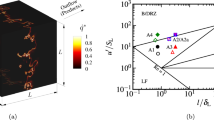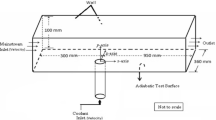Abstract
The pool fire scenario, a benchmark for fire dynamic studies, was selected to verify the influence of a combustion model. The flamelet-generated manifold (FGM) combustion model and large eddy simulation method were implemented in the fireFoam solver. Three versions of the FGM combustion model, namely basic FGM, FGM with heat equation, and FGM with radiation table, were compared in the pool fire simulation with experiment results in different mass fluxes. The fuel mass fluxes occurring in the pool fires were 0.040, 0.053, and 0.066 kg/m2 s, indicating a wide range of fuel mass fluxes. Three versions of the FGM model provided an acceptable prediction of air entrainment; however, the FGM with heat equation, compared with the other two models, was better in predicting of the fire parameters such as velocity and fluctuation. The relative error in predicting velocity fluctuation was 14.5% in the FGM with heat equation while more than 20% in other models.











Similar content being viewed by others
References
Ren F, Zhang X, Hu L, Sun X (2019) An experimental study on the effect of fire growth in a lower-floor compartment on fire evolution and facade flame ejection from an upper-floor compartment. Proc Combust Inst 37:3909–3917. https://doi.org/10.1016/j.proci.2018.07.014
Rengel B, Àgueda A, Pastor E, Casal J, Planas E, Hu L, Palacios A (2020) Experimental and computational analysis of vertical jet fires of methane in normal and sub-atmospheric pressures. Fuel 265:116878
Chen T, Yuen A, Yeoh G, Yang W, Chan Q (2019) Fire risk assessment of combustible exterior cladding using a collective numerical database. Fire 2:11. https://doi.org/10.3390/fire2010011
Fan CG, Jin ZF, Zhang JQ, Zhu HY (2017) Effects of ambient wind on thermal smoke exhaust from a shaft in tunnels with natural ventilation. Appl Therm Eng 117:254–262. https://doi.org/10.1016/j.applthermaleng.2017.02.017
Zhou L, Zeng D, Li D, Chaos M (2017) Total radiative heat loss and radiation distribution of liquid pool fire flames. Fire Saf J 89:16–21. https://doi.org/10.1016/j.firesaf.2017.02.004
Yeoh GH, Yuen KK (2009) Computational fluid dynamics in fire engineering. Comput Fluid Dyn Fire Eng. https://doi.org/10.1016/B978-0-7506-8589-4.X0001-4
Ahmadi O, Mortazavi SB, Pasdarshahri H, Mohabadi HA (2019) Consequence analysis of large-scale pool fire in oil storage terminal based on computational fluid dynamic (CFD). Process Saf Environ Prot 123:379–389. https://doi.org/10.1016/j.psep.2019.01.006
Maragkos G, Beji T, Merci B (2019) Towards predictive simulations of gaseous pool fires. Proc Combust Inst 37:3927–3934. https://doi.org/10.1016/j.proci.2018.05.162
Lu X, Yang Z, Xu Z, Xiong C (2020) Scenario simulation of indoor post-earthquake fire rescue based on building information model and virtual reality. Adv Eng Softw 143:102792
Šulc S, Šmilauer V, Patzák B, Cábová K, Wald F (2019) Linked simulation for fire-exposed elements using CFD and thermo-mechanical models. Adv Eng Softw 131:12–22
Zhang K, Ghobadian A, Nouri JM (2017) Comparative study of non-premixed and partially-premixed combustion simulations in a realistic Tay model combustor. Appl Therm Eng 110:910–920. https://doi.org/10.1016/j.applthermaleng.2016.08.223
van Oijen JA, Donini A, Bastiaans RJM, Ten Thije Boonkkamp JHM, de Goey LPH (2016) State-of-the-art in premixed combustion modeling using flamelet generated manifolds. Progress Energy Combust Sci 57:30–74. https://doi.org/10.1016/j.pecs.2016.07.001
De S, Agarwal AK, Chaudhuri S, Sen S (2018) Modeling and simulation of turbulent combustion. Springer, Berlin
Wollny P, Rogg B, Kempf A (2018) Modelling heat loss effects in high temperature oxy-fuel flames with an efficient and robust non-premixed flamelet approach. Fuel 216:44–52. https://doi.org/10.1016/j.fuel.2017.11.127
Cheung SC, Yeoh G (2009) A fully-coupled simulation of vortical structures in a large-scale buoyant pool fire. Int J Therm Sci 48(12):2187–2202
van Oijen JA (2002) 2ss flamelet-generated manifolds: development and application to premixed laminar flames 125. https://doi.org/10.6100/IR557848
Version D (2009) Incorporating unsteady flow-field effects in flamelet- generated manifolds Incorporating unsteady flow-field effects in Flamelet-Generated Manifolds. https://doi.org/10.6100/IR642962
White JP, Vilfayeau S, Marshall AW, Trouvé A, McDermott RJ (2017) Modeling flame extinction and reignition in large eddy simulations with fast chemistry. Fire Saf J 90:72–85. https://doi.org/10.1016/j.firesaf.2017.04.023
Pierce CD (2001) Progress-variable approach for large-eddy c Copyright 2001 by Charles David Pierce. Doctoral dissertation of Stanford (2001)
Marchand A, Verma S, Xu R, White J, Marshall A, Rogaume T, Richard F, Luche J, Trouvé A (2019) Simulations of a turbulent line fire with a steady flamelet combustion model coupled with models for non-local and local gas radiation effects. Fire Saf J 106:105–113
Both A (2017) RANS-FGM simulation of n-heptane spray ame in OpenFOAM
Yeoh G, Cheung S, Tu J, Barber T (2011) Comparative large eddy simulation study of a large-scale buoyant fire. Heat Mass Transf 47(9):1197–1208
Yuen AC, Yeoh GH, Timchenko V, Cheung SC, Chan QN, Chen T (2017) On the influences of key modelling constants of large eddy simulations for large-scale compartment fires predictions. Int J Comput Fluid Dyn 31(6–8):324–337
Yuen A, Yeoh G, Timchenko V, Cheung S, Barber T (2016) Importance of detailed chemical kinetics on combustion and soot modelling of ventilated and under-ventilated fires in compartment. Int J Heat Mass Transf 96:171–188
Zhiyin Y (2015) Large-eddy simulation: past, present and the future. Chin J Aeronaut 28:11–24. https://doi.org/10.1016/j.cja.2014.12.007
Pasdarshahri H, Heidarinejad G, Mazaheri K (2011) Large eddy simulation on one-meter methane pool fire using one-equation sub-grid scale model. In: MCS, pp 11–15
Cheung SCP, Yeoh GH (2009) A fully-coupled simulation of vortical structures in a large-scale buoyant pool fire. Int J Therm Sci 48:2187–2202. https://doi.org/10.1016/j.ijthermalsci.2009.04.011
Safarzadeh M, Heidarinejad G, Pasdarshahri H (2020) Evaluation of LES sub-grid scale models and time discretization schemes for prediction of convection effect in a buoyant pool fire. Heat Mass Transf 57:631–646
Yu Z, Zhang H, Ye T, Zhu M (2018) Large eddy simulation of turbulent premixed piloted flame using artificial thickened flame model coupled with tabulated chemistry. Appl Math Mech 39(9):1277–1294
Pohl BS, Frank G, Pfitzner M, Hickel JMANDS (2014) Flamelet generated manifolds for modeling turbulent non-premixed combustion in OpenFOAM. SFB/TRR40 Annual Report 2014, 209–216
Razeghi SMJ, Safarzadeh M, Pasdarshahri H (2020) Comparison of combustion models based on fast chemistry assumption in large eddy simulation of pool fire. J Brazil Soc Mech Sci Eng 42(4):1–15
Huo H, Wang X, Yang V (2014) A general study of counterflow diffusion flames at subcritical and supercritical conditions: oxygen/hydrogen mixtures. Combust Flame 161:3040–3050
Li T, Kong F, Xu B, Wang X (2019) Turbulent combustion modeling using a flamelet generated manifold approach—a validation study in OpenFOAM. Appl Math Mech 40(8):1197–1210
Mohamed Ibrahim N, Udayakumar M (2020) Coupling RSM with soot model for the study of soot formation in a momentum-dominated strained jet flames. J Therm Anal Calorim 141:2369–2389
Yu Z, Zhang H, Ye T, Zhu M (2018) Large eddy simulation of turbulent premixed and stratified combustion using flame surface density model coupled with tabulation method. Appl Math Mech 39(12):1719–1736
Yu P, Norinaga K, Watanabe H, Kitagawa T (2018) Prediction of hot coke oven gas reforming by LES coupled with the extended flamelet/progress variable approach. Fuel 231:234–243
Le VM, Marchand A, Verma S, Xu R, White J, Marshall A, Rogaume T, Richard F, Luche J, Trouvé A (2019) Simulations of a turbulent line fire with a steady flamelet combustion model coupled with models for non-local and local gas radiation effects. Fire Saf J 106:105–113. https://doi.org/10.1016/j.firesaf.2019.04.011
Yuen ACY, Yeoh GH, Yuen RKK, Chen T (2013) Numerical simulation of a ceiling jet fire in a large compartment. Procedia Eng 52:3–12. https://doi.org/10.1016/j.proeng.2013.02.097
Cheung CP (2006) Modelling of building fires coupled with turbulent, combustion, soot chemistry and radiation effects. City University of Hong Kong, Hong Kong
Coelho P (2009) Approximate solutions of the filtered radiative transfer equation in large eddy simulations of turbulent reactive flows. Combust Flame 156(5):1099–1110
Fraga G, Miranda F, França F, Janicka J, Coelho P (2020) Assessment of a model for emission subgrid-scale turbulence-radiation interaction applied to a scaled Sandia flame DD. J Quant Spectrosc Radiat Transf 248:106986
Cirrone DMC, Makarov D, Molkov V (2019) Thermal radiation from cryogenic hydrogen jet fires. Int J Hydrog Energy 44(17):8874–8885
Tieszen S, O’hern T, Schefer R, Weckman E, Blanchat T (2002) Experimental study of the flow field in and around a one meter diameter methane fire. Combust Flame 129(4):378–391
Ouyang Y, He Q, Wang C, Shen Z (2020) Numerical study of hydrogen/methane buoyant fires using FireFoam. Int J Hydrog Energy 45:13551–13558
Fancello A (2017) Dynamic and turbulent premixed combustion using flamelet-generated manifold in OpenFOAM 138. https://doi.org/10.6100/IR781467
Safarzadeh M, Heidarinejad G, Pasdarshahri H (2020) The importance of compatible sub-grid scale and spatial discretization models on the simulation of large-scale pool fire. J Braz Soc Mech Sci Eng 42(12):1–18
Maragkos G, Merci B (2017) Large eddy simulations of CH4 fire plumes. Flow Turbul Combust 99:239–278. https://doi.org/10.1007/s10494-017-9803-4
Pope SB (2004) Ten questions concerning the large-eddy simulation of turbulent flows. New J Phys 6(1):35
Maragkos G, Beji T, Merci B (2017) Advances in modelling in CFD simulations of turbulent gaseous pool fires. Combust Flame 181:22–38. https://doi.org/10.1016/j.combustflame.2017.03.012
Maragkos G, Merci B (2017) Large eddy simulations of CH4 fire plumes. Flow Turbul Combust 99(1):239–278
Marchand A, Verma S, White J, Marshall A, Rogaume T, Richard F, Luche J, Trouvé A (2018) Simulations of a turbulent line fire with a steady flamelet combustion model and non-gray gas radiation models. J Phys Conf Ser 4:042009
Wang HY (2009) Numerical study of under-ventilated fire in medium-scale enclosure. Build Environ 44:1215–1227. https://doi.org/10.1016/j.buildenv.2008.09.011
Tieszen SR, O’Hern TJ, Weckman EJ, Schefer RW (2004) Experimental study of the effect of fuel mass flux on a 1-m-diameter methane fire and comparison with a hydrogen fire. Combust Flame 139:126–141. https://doi.org/10.1016/j.combustflame.2004.08.006
Sunde B, Faghri M (2008) Transport phenonema in fires. WIT Press, pp 1–473
Miao Z, Wenhua S, Ji W, Zhen C (2014) Accident consequence simulation analysis of pool fire in fire dike. Procedia Eng 84:565–577
Zeuthen ED (2016) Radiation emissions from turbulent diffusion flames burning large hydrocarbon fuels. Masters Thesis, Oregon State University
Zeuthen ED, Blunck DL (2017) Radiation emissions from turbulent diffusion flames burning vaporized jet and jet-like fuels. Energy Fuels 31(12):14150–14160
Author information
Authors and Affiliations
Corresponding author
Ethics declarations
Conflict of interest
The authors declare that they have neither conflict of interest, nor external funding.
Additional information
Technical Editor: Francis HR Franca.
Publisher's Note
Springer Nature remains neutral with regard to jurisdictional claims in published maps and institutional affiliations.
Rights and permissions
About this article
Cite this article
Safarzadeh, M., Heidarinejad, G. & Pasdarshahri, H. Accuracy of three different versions of flamelet-generated manifold with/without radiation coupling in simulation of pool fire. J Braz. Soc. Mech. Sci. Eng. 44, 210 (2022). https://doi.org/10.1007/s40430-022-03519-6
Received:
Accepted:
Published:
DOI: https://doi.org/10.1007/s40430-022-03519-6




